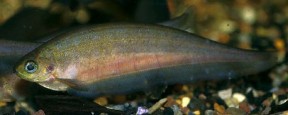Xenomystus nigri
African Knifefish
Classification
Notopteridae
Distribution
Has a diffuse natural distribution covering parts of Nigeria, Cameroon, Democratic Republic of Congo, Egypt, Chad, Liberia, Gabon, Togo, Sudan, Benin, Sierra Leone and Angola. It’s been recorded from numerous major rivers including the Nile, Congo and Niger systems.
Habitat
Said to be found most often in stiller, overgrown waters. Its sizeable natural range, various biological adaptations and ease of captive maintenance would seem to suggest it is capable of surviving over a wide range of conditions.
Maximum Standard Length
Can reach 12″ (30cm), although 8″ is usually considered a good size for a captive specimen.
Aquarium SizeTop ↑
Something around 48″ x 18″ x 15″ (120cm x 45cm x 37.5cm) – 200 litres in size would be big enough to house one of these for life.
Maintenance
Ideally the tank should contain some areas of dense planting. At the very least provide dim lighting and cover in some shape or form. Clay flowerpots, smooth stones and chunks of bogwood can all be used to create caves in which the fish can seek refuge.
You could also set up a biotope tank using African plant species such as Anubias attached to pieces of bogwood. Anubias species also have the added advantage of thriving in the rather gloomy conditions favoured by this knifefish. Soft sand is the best substrate for this type of set-up, over which can be scattered some dried oak, beech or Indian Almond leaves and peat fibre to give a really authentic look.
Water Conditions
Temperature: 73 – 82°F (23 – 28°C)
pH: 5.8 – 7.5
Hardness: 1-20°H
Diet
Like all Notopterids X. nigri is primarily carnivorous. It readily adapts to being fed in the aquarium and will accept most meaty live and frozen. Some specimens also learn to take dried foods. We suggest a varied diet including bloodworm, prawns, chopped mussel, earthworms, carnivore pellets etc.
Behaviour and CompatibilityTop ↑
Do not keep with any fish so small as to be regarded as food. Good tankmate choices include larger characins, medium sized peaceful cichlids, butterfly fish and catfish such as Synodontis, Brochis and Loricariids. It can be kept in a group when young, but as it matures it becomes increasingly territorial, particularly towards conspecifics and a relatively large tank is required to maintain a group of adult fish.
Sexual Dimorphism
Females are plumper when full of eggs. Otherwise difficult to sex.
Reproduction
Has occured in aquaria but infrequently and few details are available. The pair produce characteristic barking sounds during courtship. The male will then guard the brood of 150-200 eggs which are laid on the surface of wood or rocks and will tend them by fanning them with his fins. Apparently, the eggs hatch within 10 days, at which point the male should be removed. The fry should be fed brine shrimp nauplii or microworm as first foods.
NotesTop ↑
Originally classified in the genus Notopterus and reclassified in 1984, this is now the only described species of Xenomystus and has several interesting characteristics. Its swim bladder is specially adapted to act as an accessory breathing organ in a similar fashion to Polypteriids. It must rise to the surface to take a gulp of air periodically, often emitting a bell-like sound as it does so.
X. nigri is often confused with the similar looking but far more aggressive Asian knifefish, Notopterus notopterus. However the two species can be distinguished easily, as X. nigri lacks a dorsal fin, which is present in its Asian relative. Like other members of the family Notopteridae, this species differs from Gymnotiform knifefish in that its anal and caudal fins are fused together into one long, undulating fin, running along the underside of the fish.
It should also be noted that this is a scaleless species and is very sensitive to medications added to the aquarium. Halve the dose of any treatment required in its tank and avoid the use of salt altogether.
This is an ideal beginner’s knifefish, as it is the smallest species kept in aquaria and is very hardy. It can be very shy when first introduced to the aquarium, as it is a nocturnal species by nature but with time, it usually becomes bolder. It makes up for its lack of bright colours with its interesting behaviour and sinusoidal movement (it can actually swim backwards!) and is usually quite long-lived if maintained correctly.




October 14th, 2013 at 11:39 pm
Mine is quite a character. Despite what I read before buying it is very active by day.
It’ll come and take a look at you if you’re close to the tank, and I’ve also seen it trying quite hard to swim up the filter outlet (which is far too small) and dancing in the torrent of water and bubbles as I complete a water change.
I wonder if they’re all like this.